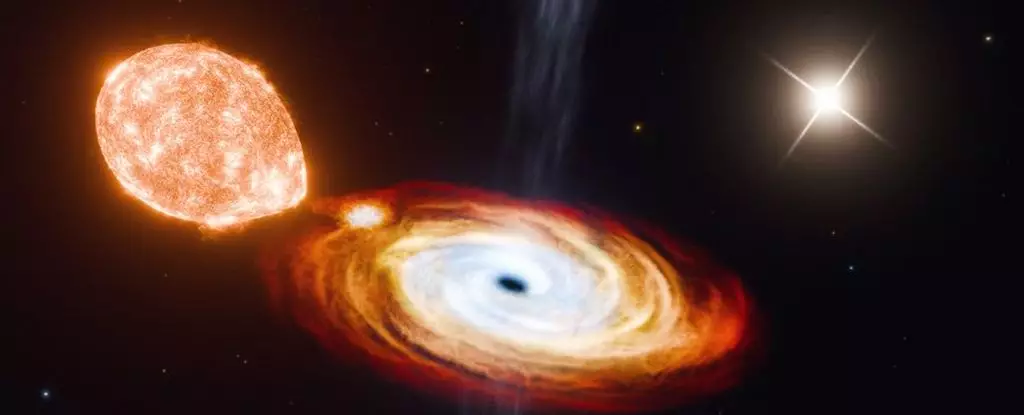In the far reaches of our universe, about 7,800 light-years away in the constellation of Cygnus, lies an intriguing astronomical system known as V404 Cygni. This phenomenon has been under scientific scrutiny for years due to its astonishingly peculiar behavior, leading to insights that challenge established theories about black hole formation. The discovery of a third celestial companion within the system has propelled V404 Cygni into the spotlight, highlighting the complexities of black hole dynamics and their formation mechanisms.
Astronomers have long been aware of the binary configuration of V404 Cygni, which includes a black hole orbiting a secondary star in a close, tightly bound orbit of just 6.5 days. However, recent revelations from the Gaia mission, operated by the European Space Agency, have unveiled a third, distant companion star that takes approximately 70,000 years to complete a circular orbit around the black hole and its closer partner. This unique trifecta raises profound questions about the formation of black holes and the nature of their companions.
Kevin Burdge, a physicist from the Massachusetts Institute of Technology, emphasizes the excitement surrounding this configuration. The existence of a third star challenges the traditional supernova explosion model, typically seen as the primary method for forming stellar-mass black holes. Burdge explains, “This discovery helps call that into question.” The implications of such a trinary system could potentially alter our understanding of black hole evolution and formation.
Traditionally, black holes have been thought to originate from supernova explosions. In this violent process, a massive star ejects its outer layers while the core collapses, leading to the formation of a black hole. Yet, the V404 Cygni system does not fit neatly into this narrative, especially given the wide gravitational separation between the black hole and its newly discovered companion. One would expect that such a distanced partner would have been dislodged following a supernova event, contradicting the very existence of the trinary system.
The challenge of reconciling this apparent discrepancy is compounded by the nature of supernovae, which can often exhibit asymmetrical energy distributions. These asymmetries typically impart a “kick” to the newly formed black hole, potentially sending it hurtling away from its former stellar companions. The substantial distance of approximately 3,500 astronomical units separating the black hole from the companion star further complicates matters, as this weakens their gravitational tether.
Given the unusual configuration of V404 Cygni, Burdge and his colleagues engaged in extensive computer simulations to explore alternative formation scenarios. These simulations overwhelmingly suggested that direct collapse could account for the formation of this trinary system. In this model, a massive star implodes completely without the outward explosion characteristic of a supernova, forming a black hole in a comparatively clean manner.
This particular finding puts direct collapse back on the table and challenges the prevailing theories that focus solely on supernova mechanisms. The idea that existing gravitational relationships could enable these kinds of systems to form raises the tantalizing possibility that many more similar systems might exist, hidden across the cosmos. Astronomer Kareem El-Badry of Caltech articulately sums up this discovery: “If they are common, that might solve some of the long-standing questions about how black hole binaries form.”
As researchers further explore the intricacies of V404 Cygni, the newfound understanding offers not only a glimpse into the mechanisms of black hole formation but also instigates a pressing inquiry into the existence of other similar systems. If trinary configurations are more common than previously thought, this could significantly expand our understanding of the dynamics and evolutionary pathways associated with these enigmatic objects.
The gravitational pull that binds the trio may open doors to evolutionary relationships possibly overlooked in binary black hole systems. As we continue to navigate this complex landscape, the V404 Cygni system serves as a reminder of the vastness of our universe and the depth of knowledge yet to be uncovered.
The unfolding narrative of V404 Cygni underscores the importance of remaining open to new possibilities in cosmology. With every discovery, there is an opportunity to challenge established norms and redefine our comprehension of cosmic phenomena. As scientists refine their tools and broaden their observational reach, the potential revelations—such as the existence of more extensive binary or trinary systems—could well illuminate the enigmatic universe that surrounds us, forever altering our understanding of black holes and their formation.


Leave a Reply